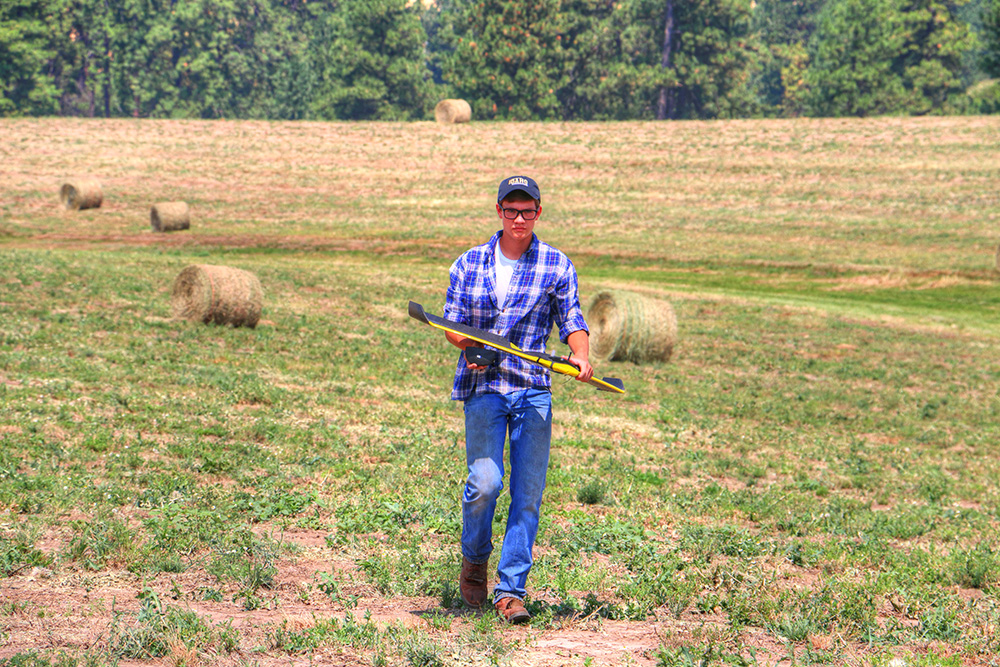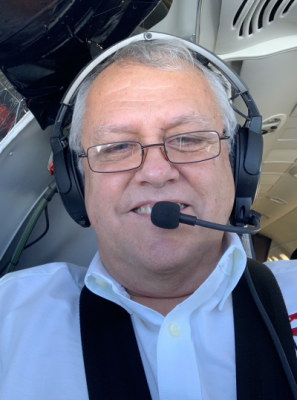While concerns around current and upcoming regulation from the FAA capture most of the headlines in the UAV industry, questions about practicalities like return on investment are even more pronounced. Those questions are especially notable in agriculture, as farmers strive to understand what sort of economic impact drones represent.
It’s for that reason I wanted to talk with Robert Blair (pictured to the right). Robert is VP Agriculture at Measure where he helped develop the Drone Flight Calculator for Agriculture, but that’s only part of the reason I wanted to chat with him. Far more relevant is his experience as a fourth generation farmer from north central Idaho, who still runs a farm that features 1,300 dryland acres of wheat, barley, peas, lentils, chickpeas, alfalfa, and cows.
I broke up the conversation with Robert into two parts, because there was just too much to get to in a single piece. In Part 1, we talk about the disconnect that exists between the general public and the agriculture industry, what he learned from his Fellowships that took him to South America, how government policy is impacting farmers, and plenty more.
Part 2 is also available now.
Jeremiah Karpowicz: As a fourth generation farmer, you obviously have experience and insight that agriculture professionals can easily appreciate. What can you tell us about growing up and then into this industry?
Robert Blair: I’ve worked on the farm my whole life. Growing up as a farm kid, you always have responsibilities. That goes from gathering eggs to picking berries and fruit to feeding animals. I got my first paycheck from milking cows. After we separated the cream, we took it down to the creamery and I would get a check for anywhere from $5.50 to $7.00 a week. Those were chores and just things you had to do everyday.
The thing is, you grow up a little quicker on a farm. You mature quicker because of those responsibilities. Before you eat breakfast, you have to make sure the animals eat, because they’re dependent on you. Those are things that make farm kids different than most. You just learn quicker because you have to.
Farming is not something you can just hop into and be an expert. There are so many different things you have to know. It also depends on your type of farming operation. If you have livestock, you have to have knowledge of those animals. That includes knowing what to do when a cow bloats, but also having the time to troubleshoot when need be, such as if you have a sick calf during the coldest time of the year and you need to spend all day taking care of it.
It’s a tough way of life, but a rewarding way of life.
Is your expertise in precision agriculture strictly related to your experience on your farm?
I went to college at the University of Idaho and was an ag business major. I still have a close relationship with the University and the College of Agriculture and Life Sciences.
I obviously learned a lot in that program, but one of the best things I got out of college was learning the computer. I remember when email came out, and I thought how stupid it was because if I needed to communicate with someone I’d talk to him or her face-to-face or call them on the phone. That opinion obviously changed in short order, but it really showed me how much of an impact technology could have on the way you approach things.
And as I understand it, thinking about a different approach was what helped you to apply for and receive an Eisenhower Fellowship in 2011, correct?
In 2006, I saw an ad in an agriculture publication on a UAV. The reason it hit home to me was because in 2004 I flew over my farm in a Cessna and was able to see my crops from the air for the first time and really look at them. And I knew right then that was the missing piece for the precision agriculture puzzle. We needed and could get timely, high-resolution images. I didn’t know it at the time, but that’s called remote sensing (laughs).
I called the number on the ad and purchased a UAV, and I was the first farmer in the US to own and use one. In fact, I was probably the first one to commercially use a UAV in agriculture, or for any commercial application maybe. I don’t know if I can fully substantiate that, but at the very least I was at the forefront of the commercial UAV industry in the United States. Through that use and the education I received by going to trade shows when I was trying to be a precision ag reseller and doing presentations, I built the necessary experience to successfully to apply for an Eisenhower Fellowship.
We’ll link to the Eisenhower Fellowship’s website, but can you give us a brief summary of what this program is and what it aims to do?
The Eisenhower Fellowship is a global Fellowship that covers the whole gamut of society. It isn’t just focused on agriculture. It involves many emerging leaders in their fields of expertise. Colin Powell is the current chairman, but Henry Kissinger, Gerald Ford and George H.W. Bush are former chairmen. It’s a huge network, but also a high level network that I’ve been blessed to be part of.
The Fellowship is designed for you to grow as a person and as a leader. They see potential in you as a leader and work to cultivate that while also helping you develop a good network of people and influence. Not only are you supposed to learn, but you’re supposed to teach. So I did just as much teaching at meetings as I did learning.
Each fellow develops his own topic of study, and my topic of study was around how remote sensing and UAVs were impacting agriculture. On my Fellowship, I went to South America, specifically to Argentina, Uruguay and Brazil, where I was able to validate my personal thesis in several different components.
What were you able to validate? What were your biggest takeaways from the experience?
I was able to see and document ROI for variable rate nitrogen. It represented a 20-25% cost savings.
At a higher level though, the experience really opened my eyes to how these countries functioned politically, socially and economically. You get exposed to a different way of life. There were many takeaways, but one of the biggest ones was that farmers are the same all around the world. They have to contend with the same issues. They have to deal with environmentalists’ attacks, poor government policy, weather and prices. So we’re all trying to find better ways to improve our farming operations, much of which goes back to technology developments like remote sensing and UAVs.
We’ll come back to that technology piece, but I know you’re passionate about the real world challenges that farmers are facing today. Let’s break down what those challenges look like and how they’re shaping the industry.
I’ve hosted Fellows from around the world on my farm, but I also host regional experts and groups. One of those is the Nez Perce tribe, and their Northern Reservation boundary goes through my farm. In 2015 they brought a group of kids up in a summer program, and being able to talk and reach out to a younger generation like that is huge. That’s not an opportunity many farmers will take and it’s a big reason for the disconnect we’re seeing from the general population as a whole.
If we take a look at the trend of people engaged in farming for a living, it’s been going down drastically since the turn of the last century. The number of people getting out of agriculture accelerated after World War II. That trend is continuing today, and it’s one of the main factors in that disconnect. If you go back a few decades ago, most people had an uncle or friend or someone connected to agriculture within one generation. That’s not the case anymore, and it’s a major factor in all of the attacks on agriculture from movements targeting GMOs, organic, natural, etc. They’re all marketing ploys to sell an inferior product for higher money. Or to stagnate tools that can help agriculture.
Why do you think these attacks are having such a resonance with the general public?
Part of it is that the American people have never been hungry. We’ve never starved. We’ve always had enough food to feed ourselves, and we’ve become complacent as a society because we don’t have to worry about food. But we’re coming to a point in time where that thinking needs to change.
My farm, which is my mom, my wife, my two sons and a hired man, means that I’m considered a corporate farm. I have enough income just to support my mom, who’s retired, my wife and I and a hired man. Quite a big corporation, eh? Nonetheless, that distinction makes me the target of those attacks.
How have you seen these attacks manifest, and what kind of an impact can and are they having?
I’ve experienced these sorts of attacks in countless ways, but the most damaging consequence is how they affect things at a policy level. The lack of knowledge the general public has around how things really work in agriculture has impacted the approach of government policy, and that’s put us in a difficult situation.
For example, people are asking and pushing for farmers to use less pesticides. That’s doable, and we can make some nice progress around that with certain technological developments. However, there’s no way around the fact that the reduction is going to negatively impact our yield. So we have to do tillage to break up things like disease cycles, but then the conversation shifts to being about how they don’t want to permit mechanical tillage because they don’t want to see soil erosion. And that brings us back to having to rely on chemicals.
The public and the government want it both ways. As a society, we really need to stop and take a closer look at government policy. If the public and the government don’t want agriculture to farm with chemicals or do tillage, then what tools are we left with? None.
So where does the ag industry go from here in terms of influencing and impacting what needs to happen at a public and policy level?
We need the public to realize their priority should be to keep farmers on the farm. The public has said they want sustainability, but it all comes down to the question of whether they’re willing to pay for it. There’s a cost to that kind of sustainability.
One of the biggest attacks we have is during the Farm Bill debate. You hear it all the time. “Farmers are getting too much money.” The reality is 80% of the farm bill is food stamps. 80%. The next two largest components are crop insurance and conservation. Those two components make up roughly 15-16% of the Farm Bill.
Crop insurance, which is under attack in Congress, has saved the government from providing ad hoc disaster relief to agriculture regions. That’s where Congress votes on some money to go into a certain region to provide relief. Now farmers pay into insurance. It’s the only self-funded program of its kind at any level of agriculture and the farmers are applying the cost. Are some of the costs subsidized? Yes, but they’ve been subsidized through those payments farmers have made. That helps insure it’s a tool to keep farmers on the farm. It’s a very important piece of the agriculture industry.
The other piece is conservation. It’s a little less funded than insurance. That’s where this technology could be funded. It needs to have better recognition within USDA and the halls of Congress. We’re dealing with the same thing at the government level that we are at the farm level. People think drones are a cool toy and not a tool. And part of that is because of the lack of regulations we’ve had up to this point.
That brings us back to the specifics of how drones can and are impacting the industry. We’ll talk about past and current FAA regulation, but where and how do you see this technology changing things?
Agriculture has the tremendous challenge and responsibility of feeding nine and half billion people by the year 2050 while doing so responsibly. In short, it’s all about that sustainability, and as I mentioned it’s what the public and government are clamoring for. So how can we do a better job?
Well, if we look back through history, not only for agriculture but on my farm, agriculture has always adopted technology. One of the reasons they’ve done that is because of labor. If we take a look at John Deere’s plow, McCormick’s reaper, or Eli Whitney’s cotton gin, those industrial revolution technologies replaced the labor that was leaving the farm. And that labor went on to work for other industries that were growing.
Today it’s not just about different technological tools though, because we’re in a technology revolution. Or the data revolution. You can call it whatever you want, but it’s geared to do the same thing. All of it is about discovering how can we use this new technology to maximize the expertise that are on the ground in agriculture. We have to do that because of the labor that’s not going to be available, and because of the amount of food that we’re going to need to produce.
You mentioned that the lack of regulations has negatively influenced the perception of farmers and the public in general. How big of a factor are regulations in the disconnect you see between those two groups, but also between farmers and their perception around what drones can do for them?
The disconnect from the public is mostly around them seeing drones as toys. It’s fine for them to want to fly for recreational purposes, but we’re flying over our farms for inherently different reasons, and I don’t think the general public understands that. Getting everyone to see and understand the impact regulations have and are still having for us is a different story though.
When I started flying, I was doing so in a very grey area at the time. The FAA had not defined commercial UAV use. By not having rules to utilize UAVs in place, research wasn’t being conducted and critical information wasn’t being gathered. We’re able to fly under the Section 333 exemptions now, and practical info is coming out. We’ll see more research papers and more scientific information to show the benefits that UAVs can provide at the field level.
That’s obviously a great thing, but we’re still feeling the repercussions of that approach. Last year I was part of a company that flew under the first agriculture exemption from the FAA. A company wanted us to fly for them, and they had over 12,000 test plots and they were looking to get a better understanding of drought stress in wheat. Unfortunately, they were located next to a small regional airport with a control tower, so we weren’t able to make it happen. Because of that, agriculture as a whole lost a generation’s worth of data because it couldn’t be flown.
What do I mean by that? The last time we had a drought in the Pacific Northwest as severe as the one we had last year that went from June 3rd to September 1st was 1977. The information that UAV’s could have collected might have been able to make a big difference in feeding our growing world’s population. It could have positively impacted the perceptions of farmers who are currently unsure what kind of real decision-making info drones can capture. It could have created an archetype that countless people would be able to learn from.
I mentioned that when you grow up on a farm you learn quicker, but anyone who takes a look at the data will see the same thing I do. UAVs can have a major impact on the way we do things today and how we can make decisions around what we’re going to do in the future.
Read Part 2 of this interview - ROI with UAVs: Drones Set to Enable an Evolution in Agriculture




















Comments